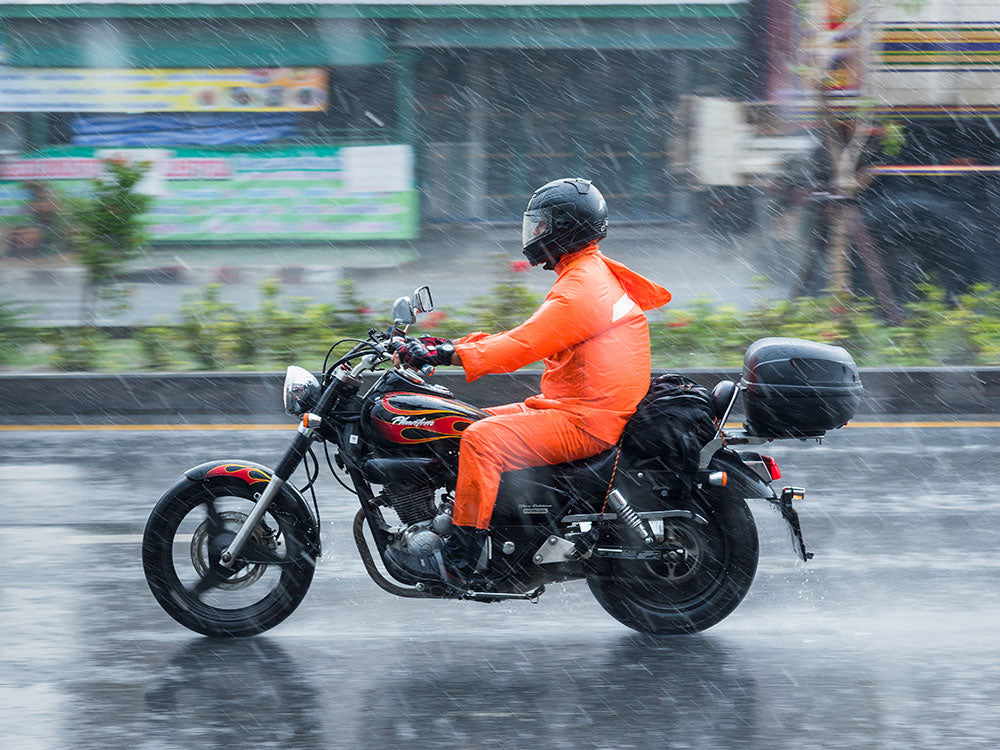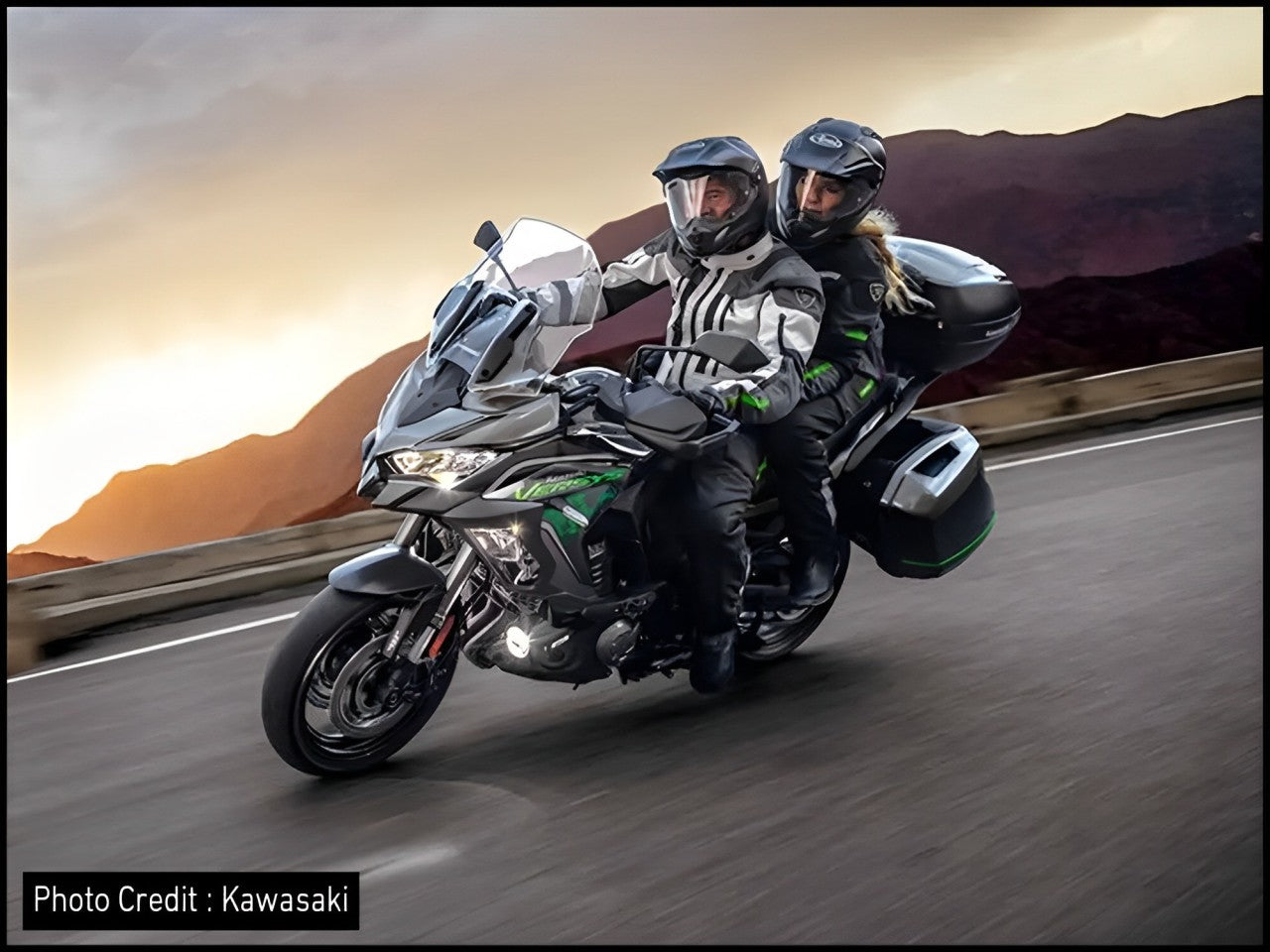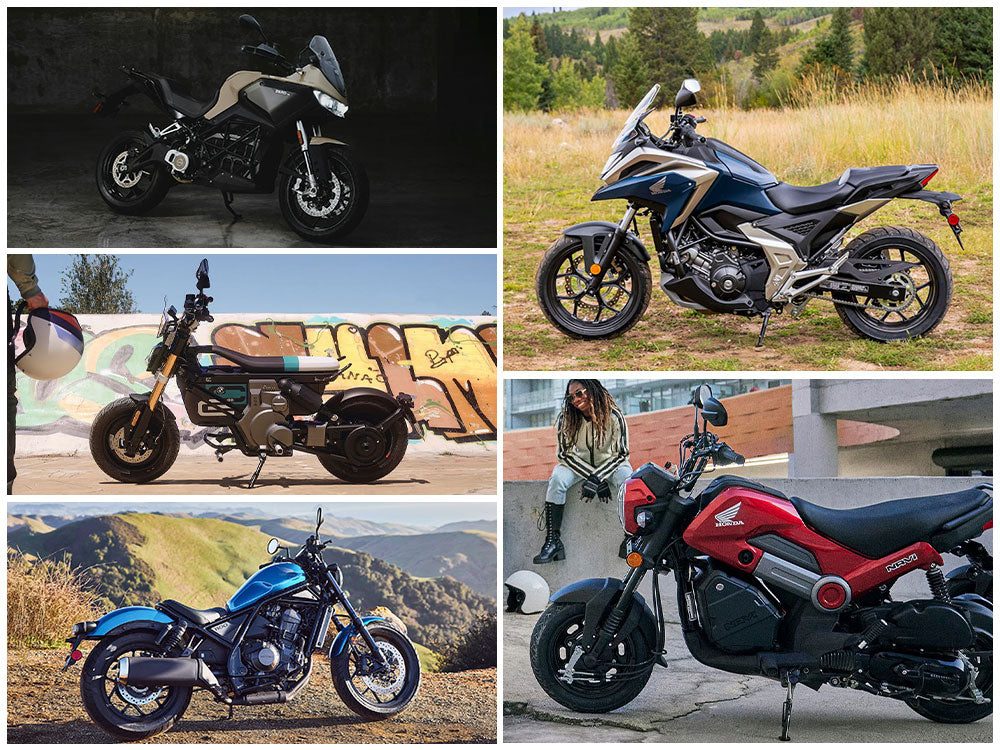Table of Content
Riding a motorcycle in the rain can cause problems with different motorcycle parts. Riders must be cautious about leaving their motorcycles in the rain as it can have several bad impacts. Meanwhile, most riders have to ride in the rain.
Usually, riding a motorcycle in the rain may not be a big issue. However, it mainly depends on how you ride a motorcycle in the rain. If the water seeps inside some critical engine components, it can cause issues. Your bike may stall and not start again until the water completely leaves the system.
In most cases, riding a motorcycle in the rain is not the bigger problem. It can only damage your motorcycle engine and degrade its performance over time, particularly if you don’t take care of your bike.
However, most of the damage is done when you ride the bike in deep rainwater on the road, also known as puddle or ponding water. Such a situation can arise if the water drainage system is poor.
Continue reading this article to learn what can happen to a motorcycle engine if you ride in the rain.
1. Are Motorcycle Engines Waterproof?

Motorcycle engines are generally waterproof. They are very much capable of withstanding rain and water. However, it doesn’t mean you should intentionally keep washing the motorcycle engine and park your bike in the rain.
Being waterproof doesn’t mean moisture will not negatively impact the motorcycle in the long run.
2. What Can Happen to a Motorcycle Engine If You Ride in the Rain?

Motorcycle engines may not get damaged if the rider rides the bike in the rain occasionally. However, the engine is further connected to several other motorcycle parts and components that may be prone to riding in the rain.
2.1 Problem with the Electrical System
Almost every modern motorcycle comes with an electric starter. The electric starter requires electrical energy from the motorcycle battery to start the motorcycle. The electrical system installed on a motorcycle is at a greater risk of getting dysfunctional if you ride more often in the rain.
If your motorcycle battery or electrical system gets out of order due to riding in the rain, your motorcycle engine will not start.
If the moisture reaches your motorcycle battery, rust will form at the terminals. Your battery will die sooner, and eventually, the bike will not start.
2.2 Problem with the Spark Plug
If the water seeps into the spark plug while riding in the rain, the motorcycle engine will either not start or stall eventually. This problem usually arises in old motorcycles with old spark plugs.
The spark plugs in modern motorcycles are usually well-protected and fully covered. Moisture or even dust cannot enter the spark plugs in these motorbikes.
However, if the water gets too much and somehow makes its way to the spark plug, it will affect the engine's performance. It can result in:
Poor acceleration
Engine stalling
Loss of power
Other engine problems
Also Read: How to Read Motorcycle Spark Plugs
2.3 Problem With the Air Intake and Air Filter
In normal circumstances, water usually doesn’t enter the air intake or filter. It depends on your motorcycle’s particular make and model. The location of the air intake and air filter varies in different motorcycles.
Motorcycle riding in the rain may not cause the water to enter the air intake. However, you must secure the air intake to avoid air filters from getting contaminated with rain water. Your air filter may be sealed properly, but if the rainwater enters the air intake, it will contaminate the air/fuel mixture.
Riding in the rain sometimes may not be a problem. However, riding a motorcycle in deep water can cause the problem. It will allow water to enter the air intake system.
2.3.1 Pod Air Filters - Exposed Air Filters
It can get damaged if the air filter or air intake is external and exposed to external conditions. If you see cruisers and touring bikes, these bikes have external air filters, also known as “Pod Filters.” The water can easily seep into these filters.
As the water enters these air filters, their ability to effectively filter the air diminishes, resulting in engine problems. For this reason, riding a motorcycle with an exposed or pod filter in the rain is not recommended, particularly when it rains heavily.
A wet air filter can significantly reduce the performance of a motorcycle engine. It offers a compromised engine combustion. When combined with the fuel, the unfiltered air doesn’t make a good air/fuel mixture.
2.3.2 Sealed Air Filters
Compared to the pod or exposed motorcycle air filters, sealed air filters are installed on various motorcycle makes and models. These air filters are usually installed under the seat or inside the sealed airbox in motorcycles. They are also more secure for riding the motorcycle in the rain.
2.4 The Rainwater Can Enter the Fuel Lines
The gas tank may not be a part of the motorcycle engine. However, there is a connection between the two. The fuel from the gas tank goes into the carburetors or fuel injectors and enters the motorcycle engine.
There are several ways through which the rainwater can enter the motorcycle engine. Firstly, as we have already discussed, rainwater can enter the engine through the air intake and air filters by getting mixed with the air/fuel mixture.
However, another way through which the water can enter the engine is through fuel lines. It is uncommon in modern motorbikes as the fuel tank and lines are very well protected and intact.
On the contrary, old motorcycles are more prone to let rainwater enter the gas tank. It is mainly because their gas tank caps are either corroded or have small openings through which the rainwater enters the fuel system.
When the rainwater makes its way to the gas tank, it degrades fuel quality. This poor-quality fuel further degrades the combustion process, resulting in poor engine performance.
Moreover, the water entering the gas tank causes rust formation. The rust flakes inside the gas tank get mixed with the fuel and enter the engine through the fuel lines. Such a situation causes performance issues and can result in engine failure over time.
Also Read: How to Clean a Motorcycle Gas Tank
2.5 Motorcycles with Low-Mounted Engines Are More Prone to Damage

Motorcycles with low-mounted engines and low ground clearance are more prone to get damaged while riding in the rain. It is not about the rainwater entering the essential engine components, air intake, and exhaust system.
If the bike has low ground clearance, the rainwater on the road and potholes are more prone to enter the engine parts.
, Cruisers, choppers, touring bikes, and performance-oriented motorcycles commonly have low ground clearance. You must be careful not to take such bikes out if it rains heavily and there is ponding water on the roads.
2.6 Rainwater Entering the Motorcycle Exhaust
Whether or not the rainwater entering the motorcycle exhaust is a problem depends on the motorcycle and exhaust system. Modern motorbikes feature a stock exhaust system with catalytic converter and drainage hole in the pipe. It doesn’t allow water to reach the engine cylinders.
However, the water will likely enter the engine if your motorcycle has a modified exhaust or a free-flow exhaust pipe. The motorcycle engine will fail if the water enters it.
Therefore, you must turn the engine off if the water enters the exhaust system while riding in the rain. Drain the water from the exhaust completely, and don’t start the engine until the water in the exhaust pipe is drained.
2.7 Rainwater Entering the Oil
If you ride in the rain more often, there is a chance that your engine oil will get contaminated. You can check the oil using the dipstick. If the oil appears to have a different color and texture than usual, it confirms that it is contaminated. Change the oil as soon as possible to avoid any engine damage.
3. Why Is My Bike Not Starting After Rain?
There can be many reasons your motorcycle is not starting after riding in the rain. If it happens to you, follow the below steps without wasting any time:
It is common for old motorcycles to stop working during the rain due to certain problems.
Identify the Problem First : Until you don’t know the problem, you may never be able to find a solution.
3.1 Check the Ignition System
If the rainwater enters the ignition system, the motorbike will stop working and will not start. It is among the most common problems a motorcyclist faces after riding in the rain.
If the water has seeped into the motorcycle ignition system, it will not produce the spark. You can simply check this by trying to start your motorcycle. If you see the current at the spark plug when the starter button is pushed, your ignition system works.
The coil and alternator inside the ignition system may stop working if moisture is present. If that is the case, you must immediately consult a mechanic.
3.2 Check the Spark Plug
If you are stuck somewhere with your bike while riding in the rain, it is probably due to a wet spark plug. The spark plug has the main duty to start the ignition system; if it doesn’t work, you may not be able to start your motorbike.
So, the first thing you should check is your motorcycle’s spark plug.
Remove the spark plug from your engine.
Remove the cover from your spark plug.
Check if there is moisture inside it.
If there is water inside the plug, dry it completely.
After drying it, press the starter button.
See if the plug produces a strong spark.
Dry the spark plug cover as well.
Ensure there is no moisture near the connection.
Connect the spark plug back to the engine.
3.3 Check Your Motorcycle Carburetors
As discussed earlier, the water is more likely to enter the fuel system if you ride a motorcycle with an exposed or pod air filter. If you find any signs of water entering the fuel system or your carburetor, follow the below steps:
You will have to drain the fuel before it reaches the engine.
Do not turn on the engine if you believe water has entered the fuel lines.
Clear out the whole carburetor basin.
Dry and clean your motorcycle air filter.
3.4 Do Not Use Your Bike and Let It Dry
If your motorcycle stops working after riding in the rain, follow the below steps:
Do not keep attempting to start the bike.
Dry the motorcycle as much as possible.
It is better if you can use an air blower for drying.
Let the bike sit in the sun for a while.
Most of the time, the bike will start just through drying.
3.5 Check the Motorcycle Battery
Remove the battery terminals.
Check the motorcycle battery to see if it is not starting after riding in the rain.
Do not turn on the motorcycle engine.
You can check the battery through the multimeter.
Check if there is moisture present around the motorcycle battery.
The moisture around the battery can corrode the terminals.
If the water enters the battery case, the battery can completely fail.
Ensure the battery is completely dry before reattaching it.
Check the health of the battery.
If it is only drained, recharge the battery.
It is time to replace the battery if it is weak or dead.
3.6 Consult a Motorcycle Mechanic
You must consult a professional mechanic if nothing seems to work out and your motorcycle doesn’t start after riding in the rain.
4. Frequently Asked Questions (FAQs)
4.1 What Happens If Water Gets Inside the Motorcycle Engine?

Water entering the motorcycle can be a nightmare as it can ruin the engine. Motorcycle engines are generally waterproof from the outside, but in extreme cases, the result can be fatal if the water enters the engine.
Water is an incompressible substance. Engines are designed to burn and compress the gases inside the combustion chamber. Water, being a liquid, when it enters the engine, the piston will fail to compress or push itself to complete the rotation around the crank axis.
The piston inside the engine will try its best to displace the water. However, due to being incompressible, the connecting rod will bounce back and start rotating in the opposite direction.
However, in most cases, the engine's connecting rod is likely to bend due to extreme force. It will result in poor engine performance and failure.
4.2 What to Do After Riding a Motorcycle in the Rain?
Riding a motorcycle in the rain is okay. However, if you leave your motorcycle unattended after riding in the rain, many problems can arise. You must follow a set of guidelines after riding a motorcycle in the rain. These include:
Inspect your motorbike thoroughly for any signs of damage or issues.
Take a dry microfiber cloth and dry your motorcycle.
Remove moisture, dust, debris, and any watermark on your bike.
Clean your motorcycle's chrome and metal parts to avoid any rust formation.
Check the whole electrical system and equipment on your motorcycle.
Wipe out any moisture you find near the electrical equipment.
Ensure they are completely dried out.
Check your battery.
Park your motorcycle in a warm and dry area.
After cleaning and drying your motorbike, cover it with a tarp.
Also Read: How to Clean a Motorcycle Engine
5. Takeaway
Riding a motorcycle in the rain is not a big problem until you don’t inspect, maintain, and dry your motorcycle afterward. Also, it depends on what type of motorcycle you ride. Is it lower to the ground? Is the air filter and air intake system exposed or external? Does the exhaust system have a drainage hole? Is it a free-flow exhaust pipe?
If you ride a motorbike with low ground clearance, a Pod air filter, and a free-flow exhaust pipe, you must take the bike out for a ride in the rain. Avoid the rain as much as possible if you don’t want anything bad to happen to the engine.
Motorcycle engines are prone to damage if water enters the combustion chamber or cylinders. A motorcycle engine can be extremely catastrophic if the piston has to displace water instead of the combustible gas. The piston rods are likely to bend as the water is incompressible.
Therefore, follow the tips and guidelines mentioned in this article. Always take precautionary measures during and after riding in the rain. It is better not to ride your motorcycle in the rain if there is too much ponding water on the roads.
















Leave a comment
All comments are moderated before being published.
This site is protected by hCaptcha and the hCaptcha Privacy Policy and Terms of Service apply.